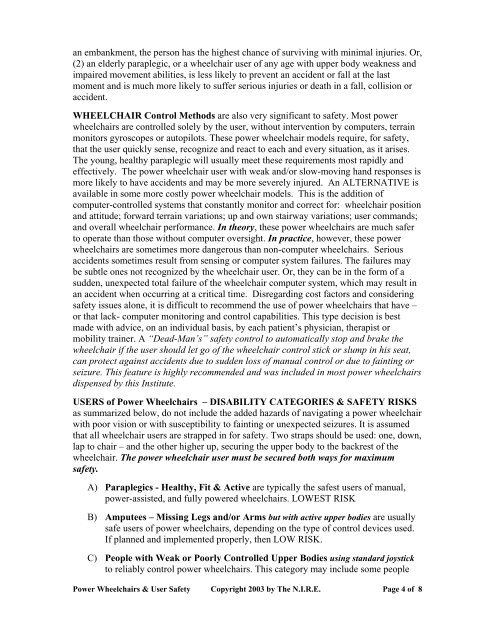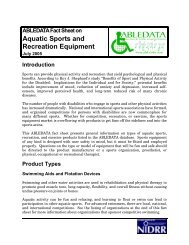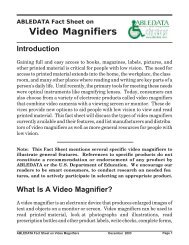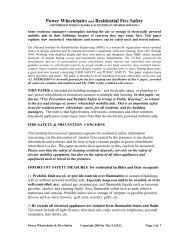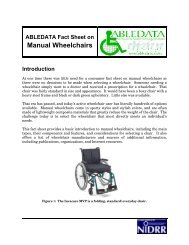Power Wheelchairs and User Safety - AbleData
Power Wheelchairs and User Safety - AbleData
Power Wheelchairs and User Safety - AbleData
You also want an ePaper? Increase the reach of your titles
YUMPU automatically turns print PDFs into web optimized ePapers that Google loves.
an embankment, the person has the highest chance of surviving with minimal injuries. Or,<br />
(2) an elderly paraplegic, or a wheelchair user of any age with upper body weakness <strong>and</strong><br />
impaired movement abilities, is less likely to prevent an accident or fall at the last<br />
moment <strong>and</strong> is much more likely to suffer serious injuries or death in a fall, collision or<br />
accident.<br />
WHEELCHAIR Control Methods are also very significant to safety. Most power<br />
wheelchairs are controlled solely by the user, without intervention by computers, terrain<br />
monitors gyroscopes or autopilots. These power wheelchair models require, for safety,<br />
that the user quickly sense, recognize <strong>and</strong> react to each <strong>and</strong> every situation, as it arises.<br />
The young, healthy paraplegic will usually meet these requirements most rapidly <strong>and</strong><br />
effectively. The power wheelchair user with weak <strong>and</strong>/or slow-moving h<strong>and</strong> responses is<br />
more likely to have accidents <strong>and</strong> may be more severely injured. An ALTERNATIVE is<br />
available in some more costly power wheelchair models. This is the addition of<br />
computer-controlled systems that constantly monitor <strong>and</strong> correct for: wheelchair position<br />
<strong>and</strong> attitude; forward terrain variations; up <strong>and</strong> own stairway variations; user comm<strong>and</strong>s;<br />
<strong>and</strong> overall wheelchair performance. In theory, these power wheelchairs are much safer<br />
to operate than those without computer oversight. In practice, however, these power<br />
wheelchairs are sometimes more dangerous than non-computer wheelchairs. Serious<br />
accidents sometimes result from sensing or computer system failures. The failures may<br />
be subtle ones not recognized by the wheelchair user. Or, they can be in the form of a<br />
sudden, unexpected total failure of the wheelchair computer system, which may result in<br />
an accident when occurring at a critical time. Disregarding cost factors <strong>and</strong> considering<br />
safety issues alone, it is difficult to recommend the use of power wheelchairs that have –<br />
or that lack- computer monitoring <strong>and</strong> control capabilities. This type decision is best<br />
made with advice, on an individual basis, by each patient’s physician, therapist or<br />
mobility trainer. A “Dead-Man’s” safety control to automatically stop <strong>and</strong> brake the<br />
wheelchair if the user should let go of the wheelchair control stick or slump in his seat,<br />
can protect against accidents due to sudden loss of manual control or due to fainting or<br />
seizure. This feature is highly recommended <strong>and</strong> was included in most power wheelchairs<br />
dispensed by this Institute.<br />
USERS of <strong>Power</strong> <strong>Wheelchairs</strong> – DISABILITY CATEGORIES & SAFETY RISKS<br />
as summarized below, do not include the added hazards of navigating a power wheelchair<br />
with poor vision or with susceptibility to fainting or unexpected seizures. It is assumed<br />
that all wheelchair users are strapped in for safety. Two straps should be used: one, down,<br />
lap to chair – <strong>and</strong> the other higher up, securing the upper body to the backrest of the<br />
wheelchair. The power wheelchair user must be secured both ways for maximum<br />
safety.<br />
A) Paraplegics - Healthy, Fit & Active are typically the safest users of manual,<br />
power-assisted, <strong>and</strong> fully powered wheelchairs. LOWEST RISK<br />
B) Amputees – Missing Legs <strong>and</strong>/or Arms but with active upper bodies are usually<br />
safe users of power wheelchairs, depending on the type of control devices used.<br />
If planned <strong>and</strong> implemented properly, then LOW RISK.<br />
C) People with Weak or Poorly Controlled Upper Bodies using st<strong>and</strong>ard joystick<br />
to reliably control power wheelchairs. This category may include some people<br />
<strong>Power</strong> <strong>Wheelchairs</strong> & <strong>User</strong> <strong>Safety</strong> Copyright 2003 by The N.I.R.E. Page 4 of 8


